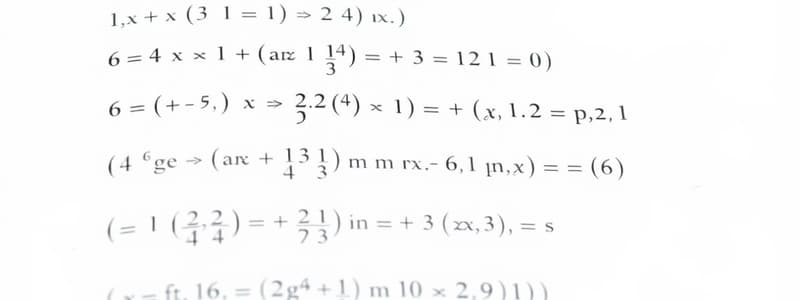Podcast
Questions and Answers
What is a variable?
What is a variable?
- A fixed quantity
- A symbol that stands for some number or represents a set of numbers (correct)
- A number that cannot change
- A mathematical constant
What is an algebraic expression?
What is an algebraic expression?
A mathematical phrase consisting of numbers, variables, and operation or grouping symbols.
What defines an equation?
What defines an equation?
A mathematical statement that two expressions have the same value.
The Commutative Property of Addition states that changing the order of addends does change their sum.
The Commutative Property of Addition states that changing the order of addends does change their sum.
State the Associative Property of Addition.
State the Associative Property of Addition.
What does the Distributive Property state?
What does the Distributive Property state?
Flashcards are hidden until you start studying
Study Notes
Variables
- Quantities that can change or vary.
- Can be represented by symbols such as 𝑥 or 𝑦.
- Represent either specific numbers or a set of numbers that solve an algebraic expression.
Algebraic Expressions
- Mathematical phrases made up of numbers, variables, and operation symbols.
- Example: 4𝑥 + 3𝑦 − 2(𝑥 + 𝑧) demonstrates combining terms and variables.
Equations
- Mathematical statements asserting that two expressions hold the same value.
- Examples include:
- 4𝑎 + 4 = 125
- 𝑥² + 3𝑥 + 6 = 0
- 2𝑛 = 8, showcasing various forms of equations.
Commutative Property of Addition
- States that the order of addends does not affect the sum.
- Mathematically expressed as 𝑎 + 𝑏 = 𝑏 + 𝑎.
- Example with numbers: 25 + 58 + 75 can be rearranged as 25 + 75 + 58, simplifying the calculation to 158.
Associative Property of Addition
- Indicates that the grouping of numbers does not change the sum.
- Expressed as (𝑎 + 𝑏) + 𝑐 = 𝑎 + (𝑏 + 𝑐).
- Example: (2 + 3) + 5 = 2 + (3 + 5) shows flexibility in grouping.
Distributive Property
- Describes how to multiply a single term by a sum of terms, maintaining equality.
- Formulated as 𝑥(𝑦 + 𝑧) = 𝑥𝑦 + 𝑥𝑧.
- Examples:
- 3(4 + 2) = 3⋅4 + 3⋅2
- 5(1 + 8) = 5⋅1 + 5⋅8, illustrating distribution in practice.
Studying That Suits You
Use AI to generate personalized quizzes and flashcards to suit your learning preferences.




